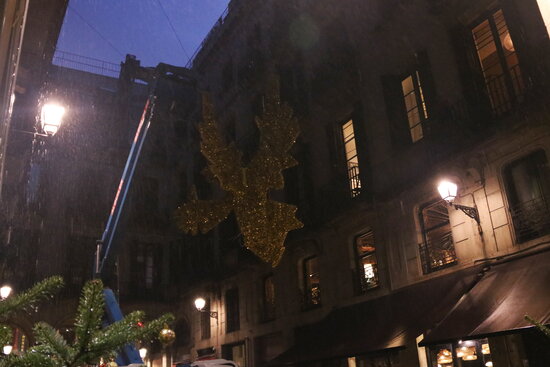Barcelona's nativity scene to stretch upwards and outwards from Sant Jaume home
More traditional nativity scenes can be seen at the Frederic Marès Museum and Pedralbes Monastery

The cobblestones of Barcelona's Plaça Sant Jaume won't be home to the square's traditional nativity scene this year, with visitors instead having to look upwards and outwards to enjoy the Christmas landscape.
Stretching all the way from La Rambla to Via Laietana, the city's 2021 nativity scene will feature figures lit up on balconies above the Old Town streets either side of the plaza, Carrer Jaume I and Carrer Ferran.
At ground level, artistic displays in 23 shop fronts will show off "the richness of city's nativity scene" heritage, says Jordi Darder, the architect behind the creation. These displays have been created by a wide range of artists, including sculptors, painters, audiovisual artists, engravers, and photographers, with local schools and residents' associations also involved.
Darder previously designed the 2017 nativity scene in Plaça Sant Jaume, and is reusing some of the pieces created for that display this year.
The façades of Barcelona City Hall and the Palace of the Generalitat (Catalan government headquarters) will also feature in the nativity scene display.
"We kept aside two figures, the ox and the mule, and after a long negotiation we decided that the ox will go on the façade of the City Hall and the mule on the Generalitat," explained Jordi Martí, Barcelona deputy mayor for culture, with an ironic smile. The cost, he added, will be around €200,000.
More traditional nativity scenes can be seen at the Frederic Marès Museum in the city center from November 27 to February 2, and at Pedralbes Monastery on the outskirts of the city from December 11 to February 2.
Controversial Christmas scenes
Debates about the worthiness of the Catalan capital's nativity scenes have become almost as traditional as the scenes themselves in recent years. Since current mayor Ada Colau was first elected in 2015, the council has tried to take a more innovative approach, but traditionalists have often lamented the more avant-garde approach of many of the commissioned artists.
The 2015 nativity scene was voted the least popular of the past decades. It aimed to celebrate the magic of fairytale animation, with scenes depicted as pop-ups from giant illustrated storybooks.
Nine giant transparent balls made up the 2016 installation. The scenes within, strange and surreal portrayals inspired by the Catalan poet Josep Vicenç Foix's work 'Ho sap tothom i és profecia' (Everyone knows, it's a prophecy), ensured one of the most divisive nativity scenes to date.
All tastes were covered for in 2017 as a minimalist design with figures elevated on poles above the square sat alongside a more traditional offering.
Everyone at the Table, the name of 2018's nativity scene, centered on family reunions and Christmas meals, with the baby Jesus depicted wearing a bib.
The last nativity scene in Plaça Sant Jaume in 2019 was from set designer Paula Bosch, whose creation was reminiscent of an attic full of boxes, themselves filled with Christmas decorations.
Even the absence of a nativity scene in 2020 due to the pandemic proved controversial. Barcelona City Council said it would be too hard to control crowd numbers in the open square but about fifty actors, musicians and residents came together to enact a live nativity scene in protest at the decision and to stand up for Catalan traditions.